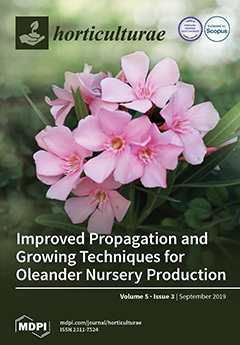Lettuce is a cool season vegetable often produced in greenhouses and other protective structures to meet market demands. Greenhouses are being increasingly adopted in warm climate zones where excessive heat often leads to physiological disorders of lettuce, such as tipburn and premature bolting.
[...] Read more.
Lettuce is a cool season vegetable often produced in greenhouses and other protective structures to meet market demands. Greenhouses are being increasingly adopted in warm climate zones where excessive heat often leads to physiological disorders of lettuce, such as tipburn and premature bolting. Greenhouse lettuce growers in warm climates need cultivar recommendations that can help improve production without ignoring marketability. In the current study, eighteen lettuce cultivars were grown in deep water culture and evaluated for growth, bolting, and tipburn in a greenhouse in Auburn, AL, starting on 30 June and 19 August 2016. Based on the severity of bolting and tipburn, nine cultivars were then selected and evaluated on 17 November 2016 for sensory attributes and marketability by 50 untrained consumer panelists. Cultivars ‘Adriana’, ‘Aerostar’, ‘Monte Carlo’, ‘Nevada’, ‘Parris Island’, ‘Salvius’, ‘Skyphos’, and ‘Sparx’ were selected as having higher heat tolerance than cultivars ‘Bambi’, ‘Buttercrunch’ ‘Coastal Star’, ‘Flashy Trout Back’, ‘Green Forest’, ‘Green Towers’, ‘Jericho’, ‘Magenta’, and ‘Truchas’. Higher crispness, lower bitterness, higher overall texture, and higher overall flavor each correlated to higher marketability, regardless of cultivar, but the strongest predictor of marketability was overall flavor. Overall flavor and overall texture were more strongly correlated to marketability than bitterness and crispness, respectively, suggesting that broader sensory categories may better capture human sensory perceptions of lettuce than narrower categories. Cultivars ‘Aerostar’, ‘Monte Carlo’, ‘Nevada’, ‘Parris Island’, ‘Rex’, ‘Salvius’, and ‘Sparx’ performed well in a hot greenhouse and were preferred by consumers. This step-wise experiment could be an adaptable tool for determining highest performing cultivars under any given production constraint, without ignoring marketability.
Full article





